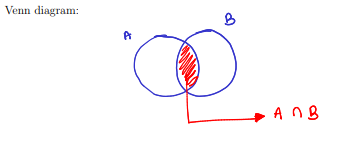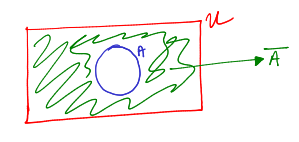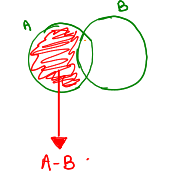Set Theory
1/23
There's no tags or description
Looks like no tags are added yet.
Name | Mastery | Learn | Test | Matching | Spaced |
|---|
No study sessions yet.
24 Terms
set
a collection of objs called ELEMENTS
the elements do not have to be of the same “type”
1 ∈ A if 1 is an element of set A
two sets are EQUAL if they:
contain the same elements no matter the order or multiplicity (ex. one set may have one 2 and the other set may have two 2’s)
sets can be:
a simple list of elements
a description of the elements that are included in the set (ex. A = {3n | n ∈ Z, 1 ≤ n ≤ 12} = {3, 6, 9, ..., 36})
commonb sets in math
set of: natural numbers (N), integers (Z), rational numbers (Q), real numbers (R), positive integers (Z+), negative integers (Z-)
empty set
denoted ∅ or {} BUT NOT {∅}
contains NO elements
universal set
denoted “U”
set of all elements that are ANALYZED (not every element that could exist, although it could mean that)
subset
let A and B be two sets.
A is a subset of B (A ⊆ B) if all the elements of A are also elements of B (A is CONTAINED in B), A could also = B)
if A is a subset of B, then for all x ∈ U, the implication (x ∈ A) → (x ∈ B) is true (if x is an element of A, then it must be true that x is an element of B)
if X is a set, then
∅ (empty set) ⊆ X is a tautology since:
(F → (x ∈ X)) is a tautology (think back to the IMPLICATION definition of a subset)
proper subset
let A and B be sets.
A is a proper subset of B if A ⊆ B and A ̸= B. If so, we write A ⊂ B.
or, A is a subset of B AND A ≠ B
cardinality
if A is a set containing EXACTLY n DISTIINCT (do not count duplicates of elements) elements (where n ≥ 0), then A is a FINITE set and its “cardinality” is n.
denote the cardinality of A by |A|. (here, |A| = n)
power set
denoted P(A)
set of ALL distinct subsets of A
P(A) = {X | X ⊆ A}
cardinality of a power set
let A be a set
if |A| = n, then |P(A)| = 2^n
cartesian product
let A and B be sets.
the cartesian product of A and B, denoted by A × B, is the set of all pairs (a, b) where a ∈ A and b ∈ B (so, rmbr that the cartesian product is a SET)
A × B = {(a, b) | a ∈ A, b ∈ B}
cardinality of a cartesian product
let A x B be a cartesian product
|A × B| = |A||B| → cardinality of A × B is equal to the PRODUCT of the cardinalities of A and B.
properties of a cartesian product
NOT commutative: A × B = B × A. is generally false
NOT associative: (A × B) × C = A × (B × C) is generally false
let A1, A2, ..., An be sets. the cartesian product A1 × A2 × ... × An is the set:
A1 × A2 × ... × An = {(a1, a2, ..., an) | ai ∈ Ai, 1 ≤ i ≤ n}
denoted by A^n
think of a squared factor like (x - 2)²
ex. let B = {1, 2, 3}, B³ = {(1,1),(1,2),(1,3),(2,1),(2,2),(2,3),(3,1),(3,2),(3,3)}
ex. R³ = {(x, y, z) | x, y, z ∈ R} = R x R x R = every 3D point that exists in R³
let A, B be two diff sets, the union of A and B:
A ∪ B = a set that contains every element in A OR B
A ∪ B = {x | (x ∈ A) ∨ (x ∈ B)} → for every element x, the set A ∪ B is where x belongs to EITHER A OR B)
see image for diagram

let A, B be two diff sets, the intersection of A and B:
A ∩ B = the set of all elements that belong to A AND B
A ∩ B = {x | (x ∈ A) ∧ (x ∈ B)}

sets A and B are DISJOINT if:
they share no similar elements
in other words, the set A ∩ B = ∅
complement of a set
the complement of a set A is denoted A’
A’ = {x | x ∈ U ∧ (x /∈ A)} → every element in “universe” that doesn’t belong to A is in the complement set

let A, B be two diff sets, the difference of A and B:
denoted as A - B (B - A would be a completely diff set)
A - B = {x | (x ∈ A) ∧ (x /∈ B)} → set of every element that belongs to A and DOESN’T belong to B

let A, B be two diff sets, the SYMMETRIC difference of A and B:
denoted as A ⊕ B
A ⊕ B = {x | (x ∈ A) ⊕ (x ∈ B)} → set of all elements that either in A or in B, but not both
A ⊕ B = (A - B) U (B - A) → symmetric difference aspect

set identities
see lecture notes 9
incorporate proof strats
rmbr the mathematical definitions of unions, intersections, subsets, etc
membership table
used to verify set identities
almost the same as a truth table
if n sets are contained in identity, then the num of rows = 2^n (same as truth table w proposition variables)
for a set A, truth value of 1 means x belongs to A, and 0 means x does not belong to A
recall that two things are logically equivalent (equal to each other) if they have the same truth values (←> “if and only if” is a tautology)
